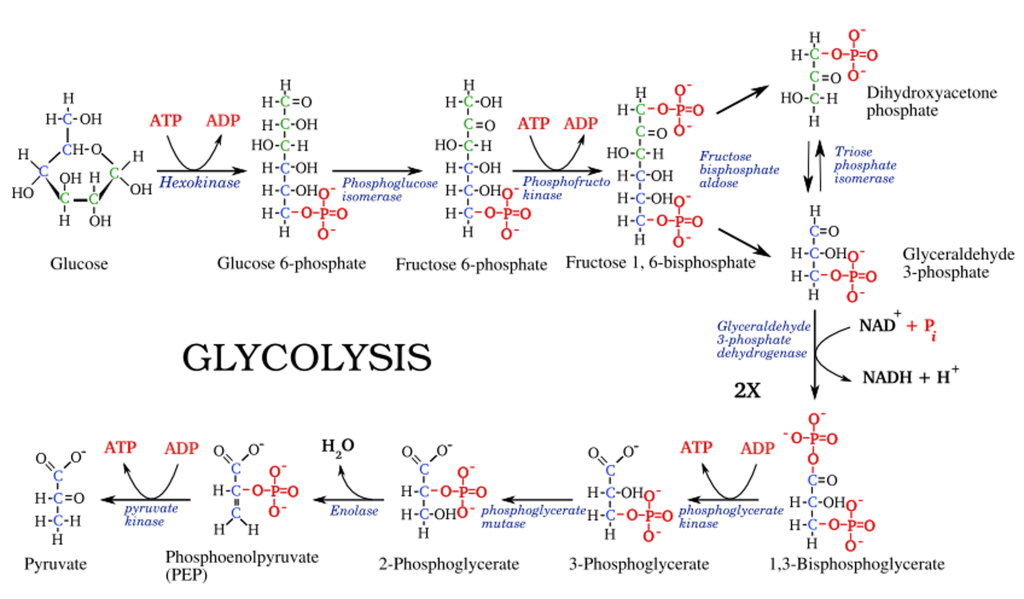Click here for questions on glycolysis.
Glycolysis Overview
Glycolysis is one of three energy systems within the body. “Glycos” is an older term for “glucose” and “-lysis” refers to “breaking down / degradation.” Glycolysis is the process of breaking down a molecule of glucose into pyruvate.
Glucose for glycolysis can come from two sources: 1) glucose molecules in the bloodstream, or 2) glycogen stores within the body are broken down into glucose molecules. During glycolysis, some ATP is “invested” by the body into the breakdown process, but the glycolysis also liberates energy within the glucose molecule, creating a net gain of ATP.
When glucose from the blood is broken down, the body invests 2 ATP molecules in the breakdown process.
1st ATP invested: a molecule of ATP adds a phosphate group to glucose, creating glucose-6-phosphate. 2nd ATP invested: a molecule of ATP adds a phosphate group to fructose-6-phosphate, creating fructose-1,6-bisphosphate.
By phosphorylating glucose and turning it into glucose-6-phosphate, the intracellular concentration of glucose remains low. This maintains a concentration gradient (high extracellular glucose and low intracellular glucose) which keeps glucose molecules flowing into the muscle cell.
After creating fructose-1,6-bisphosphate, an aldolase enzyme cleaves the 6-carbon molecule into two new 3-carbon molecules: 1) dihydroxyacetone phosphate (DHAP), and 2) glyceralehyde-3-phosphate (G3P). Triose phosphate isomerase enzyme rapidly interconverts DHAP into G3P and vice versa. One thing to remember is that since fructose-1,6-bisphosphate has been cleaved into two 3-carbon molecules, the remainder of the glycolysis pathway, from glyceraldehyde-3-phosphate to pyruvate, occurs to those two molecules.

Glyceraldehyde-3-phosphate dehydrogenase enzyme removes an H+ from glyceraldehyde-3-phosphate and transfers it to NAD+ –> NADH. An inorganic phosphate molecule is added to glyceraldehyde-3-phosphate –> 1,3-bisphosphoglycerate. Remember this happens simultaneously to two separate glyceraldehyde-3-phosphate molecules, so two NADH are created in the process.
As glycolysis continues, one of the phosphate groups of 1,3-bisphosphoglycerate is transferred to an ADP molecule to create ATP. Remember this happens simultaneously to two separate 1,3-bisphosphoglycerate molecules, so in actuality, two ADP molecules are phosphorylated to create two ATP molecules.
Two separate molecules of 2-phosphoglycerate each release a molecule of water (H20) converting 2-phosphoglycerate –> phosphoenolpyruvate.
Phosphoenolpyruvate donates a phosphate group to ADP to create a new molecule of ATP. Again, this occurs simultaneously to two separate phosphoenolpyruvate molecules, so two ATP are created and glycolysis ends with a final product of two molecules of pyruvate.
At the end of glycolysis, there are two molecules of pyruvate. Depending on the energy needs of the cell and the level of oxygen available, pyruvate will enter one of two pathways: 1) anaerobic glycolysis (aka “fast glycolysis,” or “lactic acid fermentation”), or 2) conversion to acetyl CoA for entry into the Kreb’s cycle (aka the “citric acid cycle,” “tricarboxylic acid cycle,” or “TCA cycle”).
Key Points of Glycolysis for CSCS Exam:
- Glycolysis is the process where glucose (either from the blood or from glycogen) is processed into Pyruvate.
- During Glycolysis, each ATP molecule is re-synthesized from an ADP molecule and a Phosphate molecule.
- Glycolysis occurs in the cytosol (that’s the sarcoplasm in muscle cells).
- 2 ATP are invested and 4 ATP are harvested in glycolysis that utilizes blood glucose. This provides a net gain of 2 ATP molecules per molecule of blood glucose.
- 1 ATP is invested and 4 ATP are harvested in glycolysis that utilizes glucose from glycogen This provides a net gain of 3 ATP molecules per molecule of glucose from glycogen.
- 2 NADH molecules are produced per molecule of glucose.
- 2 H20 molecules are produced per molecule of glucose.
- 2 pyruvate molecules are the end products of glycolysis.
Test your knowledge: Glycolysis Quiz